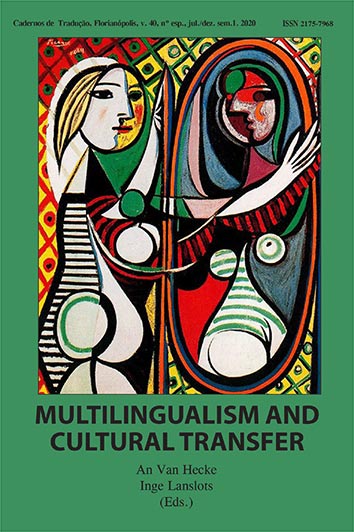A Transferência Cultural e o Bilinguismo no documentário 389 Miles: Living the Border por Luis Carlos Davis
DOI:
https://doi.org/10.5007/2175-7968.2020v40nespp113Resumo
A utilização de múltiplas línguas nos filmes envolve frequentemente a estereotipagem negativa de personagens pertencentes à uma minoria representada nesses filmes. É o caso de alguns filmes de Hollywood em que o espanhol está associado a personagens exóticos ou perigosos, confirmando de forma persistente a posição dominante da língua inglesa. No documentário 389 Miles: Living the Border (2009), o impacto linguístico e cultural da migração é visto de uma perspectiva bastante diferente. Enquanto a maioria dos documentários sobre a fronteira méxico-americana é predominantemente em inglês, possivelmente com legendas em espanhol, ou principalmente em espanhol com legendas em inglês, em 389 Miles ambas as línguas são utilizadas de forma igual. O narrador conta a história em inglês, mas utiliza ambas as línguas nas entrevistas. Há também alguns personagens que mudam do inglês para o espanhol. O objetivo deste artigo é triplo: numa primeira instância, procura examinar o documentário com o uso de alguns conceitos básicos da Teoria dos Polissistemas. O segundo objetivo é explorar a diversidade linguística. Numa terceira instância, este artigo pretende lançar mais luz sobre dois poderosos símbolos mexicanos: a Virgem de Guadalupe e a máscara do lutador. O objetivo final é descobrir como o bilinguismo nos documentários muda a nossa percepção sobre outras culturas, a travessia de fronteiras e a migração.Referências
Cammisa, Rebecca. Which Way Home. HBO Films, DVD 1h 30 m, 2009.
Codde, Philippe. “Polysystem Theory Revisited: A New Comparative
Introduction”. Poetics Today. 24-1, (2003): 91-126.
Cronin, Michael. Translation Goes to the Movies. London, New York: Routledge, 2009.
Cruz, Yolanda. 2501 Migrants: A Journey/Reencuentros. Petate Productions, DVD 57 min., 2010.
Davis, Luis Carlos. 389 Miles: Living the Border. Full Movie (2009). Avaible to:: www.389miles.com. Access in: 7 February 2020.
Deveny, Thomas. Migration in Contemporary Hispanic Cinema. Lanham/Toronto/Plymouth: Scarecrow Press, 2012.
Even-Zohar, Itamar. “Polysystem Theory”. Poetics Today. 1, 1-2, (1979): 287-310.
Fundación Mapfre. Graciela Iturbide (catálogo), del 16 de junio al 6 de septiembre de 2009. Madrid: Fundación Mapfre, 2009.
Herreras, Mari. “T Q&A”. Tucson Weekly. 14 May 2009. Avaible to: https://www.tucsonweekly.com/tucson/t-qanda/Content?oid=1184769. Access in: 7 February 2020.
Mamula, Tijana; Patti, Lisa (Eds.). The Multilingual Screen: New Reflections on Cinema and Linguistic Difference. New York: Bloomsbury, 2016.
Naficy, Hamid. An Accented Cinema: Exilic and Diasporic Filmmaking.
Princeton, NJ: Princeton University Press, 2001.
Neyoy, Cesar. “Hispanic Face. The border from a clear lens”. Bajo el Sol. 3 April 2010. Avaible to: http://myeveryday-fenceproductions.blogspot.com/2010/04/bajael-solenglish-and-spanish-version.html. Access in: 7 February 2020.
Paz, Octavio. El laberinto de la soledad. México: FCE, 1991.
Reid, Michael. Forgotten Continent. A History of the New Latin America. New Haven and London: Yale University Press, 2009.
Reyes, Rodrigo. Purgatorio: A Journey Into the Heart of the Border. DVD 1h 21m., Foprocine, La Maroma Producciones, 2013.
Ruiz-McGill, Rebecca. “UA Filmmaking Student Captures Life in His Backyard: the Border”. UA. News 8 March 2008. Avaible to: https://uanews.arizona.edu/story/ua-filmmaking-student-captures-life-in-his-backyard-the-border. Access in: 7 February 2020.
Zambrano, Jaime. “Virgen de Guadalupe, acompañante de los migrantes”. Milenio. 12 December 2017. Avaible to: https://www.milenio.com/opinion/jaime-zambrano/desde-el-biopoder/virgen-de-guadalupe-acompanante-de-losmigrantes.
Access in: 7 February 2020.
Downloads
Publicado
Como Citar
Edição
Seção
Licença
Copyright (c) 2020 Cadernos de Tradução

Este trabalho está licenciado sob uma licença Creative Commons Attribution 4.0 International License.
Autores têm autorização para assumir contratos adicionais separadamente, para distribuição não exclusiva da versão do trabalho publicada nesta revista (ex.: publicar em repositório institucional ou como capítulo de livro, com reconhecimento de autoria e publicação inicial nesta revista).





















































